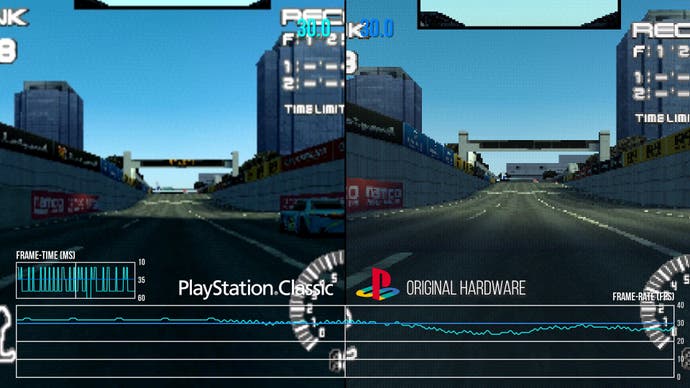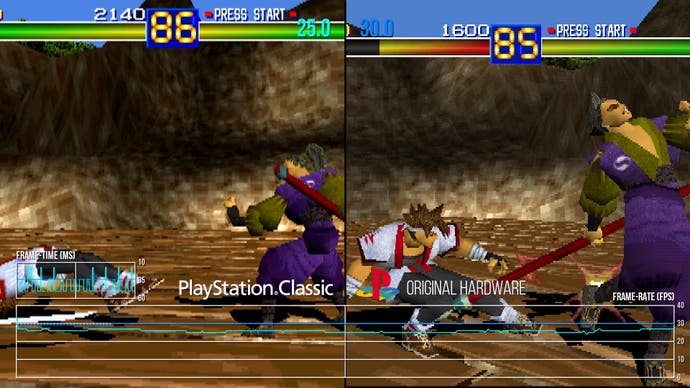PlayStation Classic mixes PAL and NTSC games - and the results disappoint
There are performance problems, too.
Something's up with the Sony PlayStation Classic - what should be a celebration of a truly iconic console is compromised by an uneven selection of games, sub-par emulation and the bizarre choice of using a mixture of both NTSC and PAL games in a machine with a locked 60Hz high definition output.
The unit certainly looks the part, successfully replicating the look of original hardware but measuring just 47x104x33mm - a mere 45 per cent of the volume of the original machine - and as Sony says, smaller than the footprint of a PlayStation 4 game case. Two replica PlayStation controllers are included - and these are facsimiles of the original controller, meaning digital control input only. This connects to the micro-console via USB. Powered by a mobile ARM chipset, the PlayStation Classic doesn't require much juice - you can power it using a micro USB phone charger, which is just as well as weirdly, there is no power adapter in the box. This is actually something of an issue as the unit is a little fussy about where it's plugged in - hooking it up to a USB 3.0 port on a PC didn't work, while plugging it into an HDTV was fine.
Going into this one, the hope was that the quality of the emulation would be high, as Sony has an excellent history in supporting PlayStation titles on later consoles, debuting its first emulator for the PlayStation Portable (PSP), with further successes on PlayStation 3 and PlayStation Vita. However, it's understood that proprietary emulation developed by Sony itself was used on those systems, while the small print suggests that the PlayStation Classic uses a mobile port of the PCSX emulator instead.

A total of 20 games are preloaded on the machine, and this is the complete list. The controversy kicks in when you look at the titles marked with an asterisk: these are the PAL games Sony has added to the mix.
- Battle Arena Toshinden*
- Cool Boarders 2*
- Destruction Derby
- Final Fantasy 7
- Grand Theft Auto*
- Intelligent Qube
- Jumping Flash*
- Metal Gear Solid
- Mr Driller
- Oddworld: Abe's Oddysee
- Rayman
- Resident Evil Director's Cut
- Revelations: Persona
- R4 Ridge Racer Type 4
- Super Puzzle Fighter 2 Turbo
- Syphon Filter
- Tekken 3*
- Tom Clancy's Rainbow Six*
- Twisted Metal
- Wild Arms
What's baffling is the inclusion of PAL versions at all, particularly when the vast majority of the PAL titles in this list were actually developed in Japan or the United States. So what's the problem here? Well, these days all console systems run at 60Hz - a format accepted by HDTVs the world over. Back in the day, PAL territories used TVs that ran at 50Hz instead, and the easiest way to 'port' games over to PAL systems was to simply run them more slowly. Most PAL games run at 83.3 per cent of the full-speed of the NTSC versions in terms of frame-rate, and most of the time in terms of actual gameplay speed too. Side-by-side with the NTSC equivalents, PAL versions are generally slow and plodding and don't properly represent a US or Japanese developer's original vision.
Adding to the sense of bafflement is that the North American PlayStation Classic has the same selection of PAL titles, meaning that for the first time, US users will get to experience the slow-motion version of Tekken 3 we had to put up with in Europe. It's bad then - really bad - but it could have been worse. PAL games also tended to feature obtrusive black borders at the top and bottom of the screen (the PAL system does have a higher resolution than NTSC, but it's only rarely utilised) but at least the PlayStation Classic clears this up, resizing the output to full resolution at the proper aspect ratio.
We've only just started to look at the PlayStation Classic (our unit arrived today) - and it's not a pretty picture right now. Remarkably, even the NTSC games have issues. You can see that with the performance snapshot of R4 Ridge Racer Type 4 embedded below. Original hardware runs this title locked at 30fps with perfect frame-pacing - a new frame is delivered every two screen refreshes without fail. Running under emulation on the PlayStation Classic, not only are frames delivered with 'blips' adding some stutter, but there also appear to be performance dips too - which do not occur in the game running on original hardware. So even if Sony had delivered a full NTSC line-up, we'd still have problems with this product falling short of the quality delivered by the actual PlayStation.

Moving onto the PAL titles, the situation worsens. Tekken 3 does indeed run at 83.3 per cent of its intended speed, but more than that is the fact that a 50Hz gameplay is dropped into the Classic's 60Hz output, giving obvious judder. Looking at raw video captures, every sixth frame is a duplicate - there isn't even the rudimentary frame-blending used in PAL PS2 Classics running on PlayStation 4. In fact, Tekken 3 also includes regular 50ms frame-time spikes - two dropped frames in succession, something that shouldn't happen.
But it's the original 30Hz titles that fare worse. As they are based on PAL code, the maximum frame-rate here will be 25fps. Looking at Battle Arena Toshinden, that is indeed the case with the PlayStation Classic's output - but it's actually worse than that as in addition to the reduced frame-rate, you also see variations in frame delivery too. There's little consistency here, meaning that gameplay suffers from obvious stutter. It's a really, really poor showing here.

We finish up with a game operating with an unlocked frame-rate - Jumping Flash. This game was hardly a performance masterpiece when it first shipped, but comparing the original NTSC release here to the PlayStation Classic's output, it's clear that there's a yawning chasm in performance here between the two systems.
There's typically a 17 per cent drop in speed transitioning from NTSC to PAL, but the effect seems to be somewhat exaggerated here, with a performance differential that can even exceed 30 per cent in favour of original hardware. We'll be looking at the emulation in more depth soon but something is clearly amiss here.

We've asked Sony for comment on the decision to use PAL versions on the PlayStation Classic and will update with any response. Fundamentally, the vast majority of these PlayStation titles were designed in 60Hz territories and even back in the day, there was a night and day difference between NTSC and sub-par PAL versions. The gap actually widens with the PlayStation Classic compared to original NTSC hardware - it's worse here, because at least back in the 90s, 50Hz software would have run on 50Hz screens, for smooth (albeit slow) gameplay. And it's worse still for potential US buyers of the Classic, who would have never experienced the slower PAL versions to begin with.
Bearing in mind the pushback from European users dissatisfied with 50Hz PAL versions in the PS2 Classics for PS4 line-up, it's just plain strange that Sony would deliver 50Hz content in any further products, and to add these games to the US release of the PlayStation Classic shouldn't have happened at all - the firm must surely have been aware that the emulated versions would offer a degraded experience over original hardware. And then there's the fact that the game emulation doesn't run NTSC 30fps games correctly - this is something that Sony has never had a problem with historically via PS1 game downloads on PSN for PS3, PSP and Vita.
First impressions of the quality of PlayStation Classic gameplay leave something to be desired then. We'll return with a full review soon, along with a deeper look at the form-factor and the overall quality of the emulation, but in the here and now, it's difficult not to be disappointed with this release.

